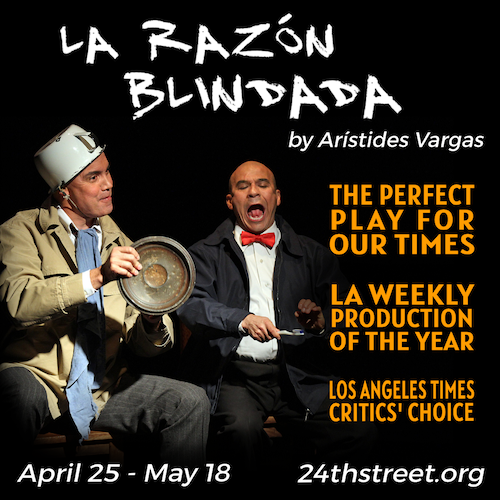The Lifespan of a Fact
Reviewed by Steven Leigh Morris
The Fountain Theatre
Through April 2
There couldn’t be a more worthy topic for a play in these fractious times: Where and how do we find truth? The question would be more potent if one could believe this play’s central premise.
The Lifespan of a Fact contains some scintillating, if inert, arguments: inert, because none of its three characters budges from their cemented, partly truthful, partly conflated, and partly nonsensical arguments. This is one of those plays where the co-authors say, well, believe what you want. Okay, thanks. Not exactly moving the dial, or even the dramatic action. It’s a bit like watching a block of ice remain frozen. You can observe it from a number of angles, which is interesting for a while, but when the theater lights dim at the end of the play, it’s still a block of ice. All that heat, and it hasn’t even dripped.
Essayist John D’Agata penned an essay for Harpers, which the magazine rejected because it failed to pass its standard of factual accuracy. At a different magazine, D’Agata teamed up with then-fact-checker Jim Fingal to write a book based on that incident, The Lifespan of a Fact, which is the basis for this comedy (landing on Broadway in 2018), and is co-written by Jeremy Kareken, David Murrell, and Gordon Farrell. In the name of truth, or maybe transparency, two of the characters are named after their real-life personae.
D’Agata, as portrayed by Ron Bottitta, is a surly, gruff writer who fashions himself on Norman Mailer. His nemesis, Jim Fingal (Jonah Robinson) comes fresh out of Harvard, an intern at the glossy NYC-based magazine that’s ready to go to press with D’Agata’s latest piece, about the suicide of a teenager who plunged to his death from a tower in Las Vegas, where D’Agata lives and teaches writing at the University of Nevada.
For Fingal’s first assignment at the magazine, editor Emily Penrose (Inger Tudor) has tasked Fingal with fact-checking D’Agata’s article, or essay, or story, or whatever-it-is. This should be a pro-forma process. Shoulda, coulda . . .
Nicely cast, Robinson’s Fingal is a diminutive figure, contrasted against the burly Bottitta’s D’Agata. The fact checker is a tenacious wasp, trailing the literary lion, finding accuracy problems with almost every sentence. By the time the trio of characters all arrive at D’Agata’s Las Vegas home to hash this out (with mutual mockery and even physical violence), Fingal has assembled a dozen case files documenting D’Agata’s embellishments and inventions. Employees at the magazine and its print shop are on overtime because of the delay, and the magazine is facing a significant cost overrun with accompanying penalty fees for missing the printing deadline. Will Penrose print this piece, kill or delay it? (She has an alternate piece in the can, on the comparatively inane topic of Congressional spouses.)
What are they hashing out? For example, D’Agata has written that there was a traffic jam at a certain intersection. In response, Fingal has created a poster-board illustration of that same intersection, with its five lanes in all directions, demonstrating that the 25 cars at the intersection referenced by D’Agata could easily have made it through unimpeded. D’Agata’s answer?: He wasn’t there, but heard his version of events from an interview with a homeless woman, whom he now can’t quote, let alone find. This is not what anybody would call trustworthy sourcing.
The coroner’s report says that the victim plunged for nine seconds to his death; D’Agata has written eight seconds because, for reasons of cadence, he prefers the sound of “eight.” (Both eight and nine have one syllable.) Meanwhile editor Penrose finds herself torn between her long-standing friendship with and respect for D’Agata, and her journalistic principles. Both Penrose and her fact-checker realize that D’Agata’s writing is brilliant. The play’s lingering question is whether or not it’s truthful, as advertised.
Both of the men are as annoying as crap, both conflate sound reasoning with absurdities, and that serves the comedy well.
Two brilliant scenes provide the play’s conundrum: Fingal eloquently argues that in this online era, when there are documents to support empirical facts, any unemployed incel has the time to rifle through Reddit or Twitter and expose D’Agata’s inconsistencies, which will be labeled as “lies.” There will be no allowance for literary license. The Internet doesn’t give such allowances, or have much appreciation for D’Agata’s brand of poeticism.
D’Agata provides a beautiful rebuttal from the chair his mother died in while facing the TV. According to the manual at the box store where D’Agata purchased this chair, for his mother, the measurements in the printed manual argue that the chair simply will not fit in that room while allowing for her wheelchair. However, the chair contains winged armrests, which expands the width of the chair, but only at an elevated height. This means that if one measures from the lower portion of the chair, it will fit, and did fit. But, D’Agata seethes, if this argument had been fact checked by you (Fingal), you would argue that, according to the manual, the chair could not have fit, therefore the woman could not have died there, did not die there, and that my story is an invention. Even the facts can be relative, in some circumstances.
All of which harkens back to a core question that goes unmentioned in the play: With all of D’Agata’s embellishments and altering of facts in the name of larger, literary truths, why can’t the editor simply frame the essay as a fiction? There’s no dishonesty in that.
To get to that question of honesty, take the case of Mike Daisey’s 2011 solo performance, The Agony and Ecstasy of Steve Jobs, in which he castigated Apple for its abusive treatment of factory workers building its products in China. NPR eventually exposed how Daisey invented so much of his own docu-performance. Daisey’s fall from grace arose from a statement he wrote in the program, claiming with some hubris and aiming for a kind of docudrama topicality, that the events of his performance were factually true; but they weren’t all true, and he got caught.
Editor Penrose makes the ludicrous suggestion that they should aim for 80% or 90% accuracy and that she can counter the remaining falsehoods with subsequent corrections, should complaints roll in. I worked with five editors-in-chief and as many section editors during my tenure at LA Weekly (a newspaper that occasionally printed fiction, and labeled it as such), and I cannot even imagine one of them considering such a fraudulent option. The aim of any credible platform is accuracy and honesty. Because even when every human effort is made to get the facts right, errors slip through. Everybody knows that. And that’s what the contingency of “corrections” is for. If any of them were caught knowingly letting through a 10% ratio of falsehoods or lies, for the sake of expedience, they would or should have lost their jobs.
The core issue for Mike Daisey, and for editor Emily Penrose in this play, is not truth, or truthiness, or literary or poetical license. It’s deceit: the betrayal of an implied agreement, or, in Daisey’s case, an explicit mention printed in the program, that the work is factually true rather than poetically or lyrically based. (When D’Agata argues that lyrical truths can be truer than literal truths, he’s arguing for poetry, and that’s a strong argument when one comes clean that one’s work is fiction. But writing fiction and framing it as fact is an entirely different matter.)
The play’s suspense is built around the unanswered question of whether Penrose will let the story go to print, but it’s a contrived dichotomy. There’s a remedy available to her, and this comedy cannot retain credence without considering it. If she loves D’Agata’s writing so much, if it’s truly in the tradition of Norman Mailer and Joan Didion, all she has to do is label it as a fiction, or an “interpretive essay based on the suicide of . . .” That framing eliminates the element of deceit, any implication of implied factual veracity, and permits the kind of literary license that means so much to the author. Then the only remaining concerns are libel and defamation, which don’t seem to be at issue here.
The play contains two locales, the editorial office of the NYC magazine, and D’Agata’s Vegas home. Set designer Joel Daavid combines the two with polished wood facades, and Nicholas Santiago’s backdrop video beautifully transitions a window-view desert suburb landscape, from glaring sunlight through sunset.
Simon Levy’s solid staging is visually arresting, and the men’s sparring is a delight largely derived from their dichotomous appearance and temperaments – even if that witty sparring ultimately takes them into dead-ends rather than any transformation. Editor Penrose, as the tortured arbiter, is less nimble and animated, more measured and mannered, as though weighed down by the gravity of her plight.
A play doesn’t need to be true, but it does need to be truthful, which means plausible. Here, just like its characters, it dances with mirages.
The Fountain Theatre, 5060 Fountain Ave., Hlywd.; Fri-Sat. & Mon., 8 pm (dark March 13); thru April 2. https://fountaintheatre.com Running time 80 minutes, no intermission












